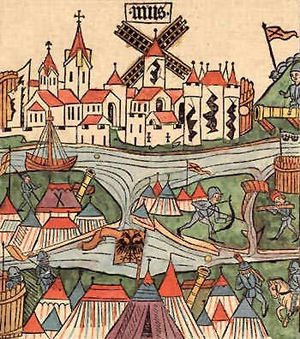Burgundian Wars
| Burgundian Wars | |||||||||
|---|---|---|---|---|---|---|---|---|---|
 The Siege of Neuss (1474–75), from Geschichte Peter Hagenbachs und der Burgunderkriege (1477) by Konrad Pfettisheim |
|||||||||
|
|||||||||
| Belligerents | |||||||||
|
|
|
||||||||
| Commanders and leaders | |||||||||
|
Duke of Burgundy † |
|
||||||||
The Burgundian Wars (1474–1477) were a conflict between the Dukes of Burgundy and the Old Swiss Confederacy and its allies. Open war broke out in 1474, and in the following years the Duke of Burgundy, Charles the Bold, was defeated three times on the battlefield and killed in the Battle of Nancy in 1477. The Duchy of Burgundy and several other Burgundian lands then became part of France, while the Burgundian Netherlands and the Franche-Comté were inherited by Charles's daughter Mary of Burgundy, and eventually passed to the House of Habsburg upon her death because of her marriage to Maximilian I, Holy Roman Emperor.
The dukes of Burgundy had succeeded, over a period of about 100 years, in establishing their rule as a strong force between the Holy Roman Empire and France. Their possessions included, besides their original territories of the Franche-Comté and the Duchy of Burgundy, the economically strong regions of Flanders and Brabant as well as Luxembourg.
...
Wikipedia
